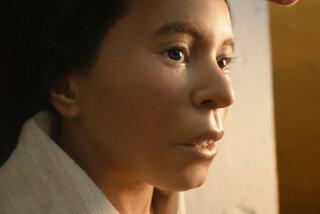3,000 Years Before Egyptians : Mummies From Chile Called World’s Oldest
- Share via
ARICA, Chile — Long before the ancient Egyptians were mummifying their Pharaohs, the people of the coastal lands of what is now northern Chile had developed their own complex preservation techniques for the world’s oldest mummies.
Carbon tests on remains of about 100 bodies, found three years ago by accident in Arica, 1,280 miles north of Santiago, showed that some were nearly 10,000 years old, predating the earliest known Egyptian mummies by 3,000 years.
“There is no doubt that we have here the world’s oldest known mummies,” Marvin Allison, an American researcher with the local University of Tarapaca, said.
But scientists still puzzle over the elaborate ritual used by the primitive hunters to preserve their dead.
Existence Long Known
The existence of ancient mummies in this region of the Atacama Desert, where the extreme dryness acts as a natural preserving agent, had long been known.
But it was only in 1983, when excavations by a local water company uncovered the mass remains, that modern scientific dating tests were made.
Scientists at the university say that the techniques used by primitive hunters and fishermen, given the name of Chinchorro after a nearby beach, were at least as sophisticated as those used by the Egyptians.
The Egyptians believed that man had two souls, one of which would return periodically to the body, which therefore needed to be kept fit. But the thinking of this primitive South American people is a mystery.
Bodies Made Rigid
Allison said that the Chinchorros went to great trouble to make the bodies rigid, reinforcing the bones with sticks. He suggested that they were never intended for burial and could have stood upright like statues.
Like deathly sentinels, the figures could have ringed the primitive encampments acting as a sort of magic shield.
Alternatively, these people could have considered that by mummifying some particularly successful hunter, his power would remain to guide the living, Allison said.
Aside from reinforcing of the bones, the statue theory is supported by the fact that none of the mummies was in perfect condition and that some had clearly been repaired.
All Were Damaged
“We would normally expect to find at least one perfect example, but all these were damaged,” he said.
The damage, particularly to heads and feet, was consistent with natural causes, such as earthquakes, Allison said. Or they may have been knocked down when the subject was considered to have lost his magic power, he said.
“For the Egyptians, the mummification was done for the benefit of the dead, but here it was clearly to help the living,” said Allison, a clinical pathologist who studies the history of disease.
“It appears probable that it (mummifying) formed part of some death ritual, but we can only speculate,” said Mario Rivera, director of Arica’s Anthropological Museum, which houses some of the remains.
‘Family’ at University
Within the university museum, a “family” of four mummies--a man, woman and two small children--lie like macabre scarecrows on a bed of sand, sticks protruding from the dried, blackened skin on the arms and legs.
There is no evidence to suggest they were related, although Allison said there was a tendency for the mummies to be collected in families, perhaps reflecting the group nature of hunting.
“Perhaps they felt they could not leave a mighty hunter by himself, because his family would help to cut and carry the meat,” Allison said.
The preservation process used was complex and reveals a remarkable knowledge of anatomy, Rivera said.
Clay Mask Attached
The flesh was stripped from the bones, with neat cuts presumably learned from skinning animals. The brain and major muscles were removed and the cavities filled with clay, vegetable matter and ash.
Facial bones were covered with a clay mask, and the hair was formed into a wig. The skin was then pulled back on like a glove over the bones and the body covered in a primitive black paint.
“The whole process could not have taken more than two days, because longer than that and the skin would begin to disintegrate,” Allison said.
The ritual also revealed a previously unsuspected degree of social organization at a time when the occupants of Latin America had been thought to be little more than marauding scavengers, he said.
More to Read
Sign up for Essential California
The most important California stories and recommendations in your inbox every morning.
You may occasionally receive promotional content from the Los Angeles Times.













